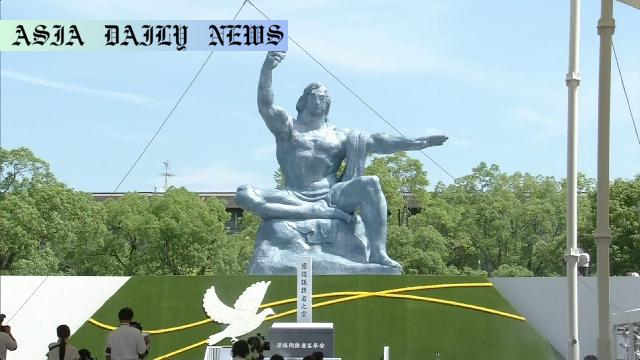Nagasaki: Russia’s ambassador to Japan joins peace ceremony for the first time since Ukraine invasion amid diplomatic developments.

The Significance of Nagasaki’s Peace Ceremony
Nagasaki, a city that carries the profound scars of history, is set to mark the 80th anniversary of the atomic bombing on August 9, 2023. This annual peace ceremony holds immense importance as it serves as a solemn reminder of the devastation caused by nuclear weapons while emphasizing the urgent need for global disarmament. This year, the event takes on even deeper significance as Russia’s ambassador to Japan, Nikolay Nozdrev, confirms his attendance for the first time since his country’s invasion of Ukraine in 2022. The symbolic presence of Russia at such an event underscores potential avenues for diplomatic engagement amidst growing global tensions.
A Shift in Nagasaki’s Approach
In previous years, Nagasaki refrained from inviting representatives from Russia and Belarus, reflecting the geopolitical tensions surrounding the invasion of Ukraine. However, in a move to promote inclusivity and dialogue, officials have extended invitations to all countries and regions with diplomatic missions in Japan this year. The decision to reintroduce Russia into the fold signals a commitment to fostering communication despite existing conflicts. This thoughtful inclusion highlights Nagasaki’s dedication to transcending political divides and focusing on the broader vision of global peace and nuclear abolition.
Historical and Diplomatic Context
The atomic bombings of Hiroshima and Nagasaki remain some of the most harrowing chapters in human history. These events not only devastated entire cities but also brought the horrors of nuclear warfare into grim focus. The peace ceremonies conducted annually in these cities have since become pivotal platforms for advocating nuclear disarmament. Russia’s participation, especially given its prominent global political role and current controversies, brings new dimensions to this year’s ceremony. While Ambassador Nozdrev will attend the Nagasaki ceremony, he will not participate in Hiroshima’s event on August 6, signaling a nuanced approach to engagement. Nagasaki’s inclusive stance aligns with the historic mission to transform tragedy into a call for collaborative progress.
Engaging with Survivors and Global Leaders
Adding further depth to the commemorations, Joergen Frydnes, chair of the Norwegian Nobel Committee, will make a four-day visit to Hiroshima and Nagasaki this July. Frydnes’ exchanges with hibakusha (atomic bomb survivors) and other dignitaries underline the universal message these ceremonies strive to deliver. Through dialogue with leaders and survivors, the events amplify calls for denuclearization. The Nobel Committee’s previous acknowledgment of Nihon Hidankyo, an organization of atomic bomb survivors advocating for nuclear abolition, is a testament to the ongoing importance of these efforts. The collective voice of survivors continues to urge the world to take definitive steps toward eliminating nuclear threats.
Steps Towards Unity and Reconciliation
This year’s ceremony powerfully illustrates Nagasaki’s role as a global symbol of peace and resilience. The decision to invite Russia amid geopolitical tensions is not just a gesture of diplomacy but also a profound reminder that unity and dialogue must prevail even amidst conflict. By fostering participation from nations, including those involved in contentious issues, Nagasaki reinforces the belief that humanity must collectively work towards a future free from the shadow of nuclear conflict. With voices from survivors at the forefront, alongside global leaders, the city continues to inspire hope and action on an international scale.
Commentary
Nagasaki’s Symbolic Gesture of Inclusivity
Nagasaki’s decision to invite all diplomatic missions, including Russia, represents a bold and meaningful step toward fostering dialogue in an increasingly polarized global environment. This choice reflects the city’s unique position as a symbol of both unimaginable tragedy and unwavering hope for peace. In a time of geopolitical challenges, this invitation stands as a reminder that discussions and unity can serve as powerful tools to bridge divides. By including Russia, Nagasaki has demonstrated a resilience that mirrors its history—choosing reconciliation and shared understanding over exclusion.
The Role of Hiroshima and Nagasaki in the Global Peace Arena
For decades, Hiroshima and Nagasaki have been at the forefront of advocating against the use of nuclear weapons. These cities have transformed their painful histories into rallies for global action, ensuring that the events of 1945 serve as lessons for future generations. The addition of figures like Joergen Frydnes from the Nobel Committee only strengthens their narrative of abolition and hope. These discussions spark critical discourse around nuclear disarmament, human suffering, and the collective responsibilities of nations to ensure that history does not repeat itself.
A Long Road Ahead
Despite these deeply symbolic efforts, the road to global disarmament and peace remains fraught with challenges. The world continues to grapple with conflict, political alliances, and differing priorities. It is paramount that cities like Nagasaki persist in their efforts to remind global citizens and leaders of the imperatives of peace. Through events like the upcoming ceremony, Nagasaki proves that even wounds as deep as those inflicted by nuclear war can become catalysts for unity. In this, the city echoes a universal need for action and reminds us of the humanity that connects us all.


